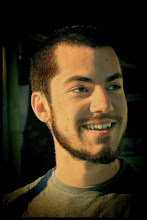Shot of camp again - the photos in this post consist of some of my favorites of the season
All in all, if you hadn’t gathered
from all my posts leading up until now, it was an amazing summer. A unique
experience, living in the middle of the wilderness with 5-7 other people worked
out quite well since our crew was all good-humored, hard-working, and fun to be
around. The potential for social disaster in small field crews is a definite
reality, luckily one that was mainly avoided in this case.
The nature up there was out of this
world, both at the Canning and then in our post-trip to the Kenai Peninsula. We
only had 70 or so species of bird at the field site on the North Slope, but
some of them that I talked about above, such as Spectacled Eider or
Buff-breasted Sandpiper, are truly special.
Buff-breasted Sandpipers displaying
Of course, not all in the world is
birds, as I need to be reminded sometimes, and the mammals exemplified this
fact well. We ended up with 21 species of mammals throughout the whole trip,
including roughly 30,000 caribou, all members of the Porcupine Herd, a well-known
herd of animals that totals around 150,000 individuals whose seasonal migration
takes them right past the area of our camp. The large carnivore show was also
very impressive, like the American Serengeti as I said before, with eight
Grizzly (Brown) Bears, 6 Gray Wolves, and daily Arctic Foxes. The mammals did
not stop down in the Kenai area, illustrated with Black Bear and Orca, Mountain Goat and
Humpback Whale, Sea Otter and Moose.
Pacific Loon
Apart from the flesh-and-blood life
up there, the landscapes and other biota were awesome too, with massive
expanses of spongy tundra extending as far as you can see up on the North
Slope, to down in the Kenai where large evergreen forests dominate, where you
silently walk under the boughs of the conifers on a bed of needles, a world
apart from the other side of the state. One of the things that struck me was
how primal and wild most of the state still was, even in some areas off of main
roads – something that we never really encounter down in the lower 48 states.
American Golden-Plover
I know I have been trying to
describe what it was like up there, but there is no real way to convey the
experiences exactly as they were. There were the times when you’re slogging
through knee-deep water with a 30lb pack, 7 layers on, toting a shotgun, and
then the fog rolls in and you can’t see 20 feet away, no knowledge of where you
are, where anything else is, and it doesn’t really matter. An hour later the
sun could be out, the wind could die, and you could be stripping down to just a
thermal layer over your tshirt, and throw on sunglasses, suddenly able to see
dozens of miles at the frosted mountains standing vigil over the flatness. You
might be walking along and get the feeling you’re being watched, only to turn
around and see an Arctic Fox or a Caribou not too far behind you, just watching
you.
Sabine's Gull
One of the many unique experiences
that came with the trip up there was that of being cut off from the world. I’ve
traveled extensively in Latin America, but even there you go to an internet café
every few days at the most. Here you get your 10 minutes of satellite phone a
week, and that is it. No knowledge of news, politics, sports, gossip, anything.
And it was wonderful.
Our final tally for our 5 week season up
there was 288 nests found, of which roughly 80% failed due to predation by
Arctic Foxes, with another 3-5% unknown whether they were predated or if they
hatched. This is a slightly above average for nests found, but extremely above
average for predation. At other sites along the North Slope they had normal
success years, so it appears to have been an isolated occurrence, and one that
will surely even out over time, since it is just part of the rhythm of nature.
Red-necked Phalarope
It was an incredible experience
overall, one that I am honored to have been a part of, and definitely something
I’m considering returning to next year. Thanks all for reading, and perhaps I’ll
find some more topics to write about from the New England area before I travel
again – time shall tell.
For more photos than have been shown here, see the below links:
Canning River: http://www.flickr.com/photos/uropsalis/sets/72157630544961418/
Kenai Peninsula: http://www.flickr.com/photos/uropsalis/sets/72157630730893230/
For more photos than have been shown here, see the below links:
Canning River: http://www.flickr.com/photos/uropsalis/sets/72157630544961418/
Kenai Peninsula: http://www.flickr.com/photos/uropsalis/sets/72157630730893230/







1 comment:
I can see why you would want to head back up there again.
Post a Comment